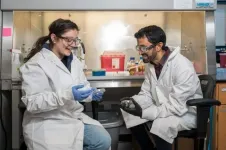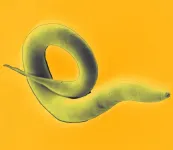(Press-News.org) Scientists and engineers are constantly looking for ways to better our world.
Synthetic biology is an emerging field with promise for improving our ability to manufacture chemicals, develop therapeutic medicines such as biopharmaceuticals and vaccines, and enhance agricultural production, among other things. It relies on taking natural or engineered pieces of DNA and combining them in new ways in biological systems, such as microbes, bacteria or other organisms.
According to University of Delaware's Aditya Kunjapur, assistant professor of chemical and biomolecular engineering, as these sophisticated microbial technologies are advanced, scientists need to explore ways to keep these organisms from ending up in the wrong environment.
For example, a bacterium that is good at making large amounts of chemicals is great in a bioreactor, but it isn't necessarily what we would want in the environment or in our food. Similarly, a specialized bacterium developed to help a plant be more productive is useful in agriculture, but we might not want that same bacterium to end up in our bodies.
Engineering traits directly into the microbe to create built-in safeguards to control where it can grow, known as biological containment, is one promising solution.
"Having the ability to control where microbes grow will help create technologies to treat disease and clean up the environment more safely," said Kunjapur, an emerging leader in biosecurity with expertise in teaching cells to create and harness chemical building blocks not found in nature.
Now, Kunjapur is the lead author of a new paper published in Science Advances on Friday, July 2 that describes progress on the stability of a biocontainment strategy, first reported in 2015, that uses a microbe's dependence on a synthetic nutrient to keep it contained. The work was done in collaboration with Harvard Medical School (HMS) and includes co-authors now at HMS, UD, Johns Hopkins University and industry.
Under lock and key
In the paper, the research team studied a strain of Escherichia coli (E. coli) that was made to depend on a synthetic nutrient for its survival, a method known as synthetic auxotrophy. They found that the strain remained stable and maintained this dependence when grown for 100 days.
"You can take enzymes that the bacteria need to grow and make them depend on a man made building block, something it will never see in nature," said Kunjapur.
The work builds on previous research in the Church lab at Harvard Medical School, where most of this research was conducted and where Kunjapur completed postdoctoral work. In that study, the research team showed that if one enzyme required this synthetic building block, bacteria would quickly find a way out. But if three enzymes required the synthetic building block, the bacteria couldn't "unlock the cell door" within a 24-hour period to make a quick getaway.
"Asking the microbe to mutate its genome in precisely three different ways at the same time is too much, and it won't find that solution," said Kunjapur. "So, while the same 'key' might open all of the doors, the microbe can't be at all three doors at once to open them, so it remains contained."
The question was whether they would find a way out if given more time to grow.
In this new work, as the research team extended the study and grew the E. coli strain, nicknamed DEP, continuously for 100 days, they also applied extra stress by shrinking the amount of synthetic nutrient the bacteria received over time.
In three parallel experiments, the researchers found that the DEP E. coli was unable to find a way to "escape" or grow outside the cell. It did, however, adapt to a lower concentration -- 10 times less -- of the synthetic nutrient it needed to survive. Further, the research team found that proteins on the host cell's surface changed, which had not been seen before.
"We think that as we were decreasing the amount of the nutrients, the DEP E. coli modified the proteins on the surface of the cell that regulate how much synthetic nutrient is allowed inside in order to retain more nutrients inside and keep growing," said Kunjapur. "We were surprised because at first we didn't expect them to adapt, and then we didn't expect them to adapt in this way."
To validate their results, the team went back and engineered those same genetic traits into the original ancestor E. coli strain and discovered it was able to grow at the lower synthetic nutrient concentration from the start. This information could prove useful for scaling the experiment in the future, Kunjapur said.
In a follow-up experiment, Kunjapur's colleague Eriona Hysolli, a postdoctoral fellow in the Church lab, added the bacteria directly to mammalian cells. The results were intriguing. While the bacteria grew tremendously in the first few days, over the course of a week the bacteria just faded away, without the need for antibiotics.
"Our data show the first use of recoded bacterial strains with controllable growth in a mammalian cellular model. We are excited about the promising applications in human health like the gut microbiome," said Hysolli, a co-author on the paper.
Building on this work, Michaela Jones, a UD doctoral student in Kunjapur's lab and paper co-author, conducted additional experiments that showed the bacteria stopped growing when the synthetic nutrient was taken away, then resumed growth when the nutrient was added back. Kunjapur said these findings equip researchers with new tools to control how and when bacteria grow by regulating the nutrients they need to survive.
"Now, if you need bacteria to grow at a certain rate or time, we have a synthetic building block as a lever or knob to control that," he said.
In future work, Kunjapur plans to study the biocontained DEP E. coli strain, as well as other microbe designs, under a broader set of conditions to determine if the approach will hold up in the environment. Additionally, he is working on biomedical applications for live bacterial strains, which could be used as therapeutics, probiotics and vaccines.
INFORMATION:
UNIVERSITY PARK, Pa. -- What if the COVID-19 virus could be used against itself? Researchers at Penn State have designed a proof-of-concept therapeutic that may be able to do just that. The team designed a synthetic defective SARS-CoV-2 virus that is innocuous but interferes with the real virus's growth, potentially causing the extinction of both the disease-causing virus and the synthetic virus.
"In our experiments, we show that the wild-type [disease-causing] SARS-CoV-2 virus actually enables the replication and spread of our synthetic virus, thereby effectively promoting its own decline," said Marco Archetti, associate professor of biology, Penn State. "A version of this synthetic construct could be used as a self-promoting ...
UNIVERSITY PARK, Pa. -- The fast-moving decline and extinction of many species of detritivores -- organisms that break down and remove dead plant and animal matter -- may have dire consequences, an international team of scientists suggests in a new study.
The researchers observed a close relationship between detritivore diversity and plant litter decomposition in streams, noting that decomposition was highest in waters with the most species of detritivores -- including aquatic insects such as stoneflies, caddisflies, mayflies and craneflies, and crustaceans such as scuds and freshwater shrimp and crabs.
Decomposition ...
ABINGTON, Pa. -- Counterfeit dominance decreases Anglo-American, but not Asian, consumers' quality perception and purchase intention of authentic brands, according to a team of researchers.
"Counterfeit dominance is the perception that counterfeit products possess more than 50% of market share," Lei Song, assistant professor of marketing at Penn State Abington, said. "Counterfeit dominance is a phenomenon especially concerning for the luxury fashion industry as counterfeit luxury fashion brands account for 60% to 70% of the $4.5 trillion in total counterfeit trade and one-quarter of total sales in luxury fashion goods."
Lei and his team conducted four behavioral experiments with 149 participants on ...
Increased labour mobility seems to have stopped the racial wage discrimination of black English football players. A new study in economics from Stockholm university and Université Paris-Saclay used data from the English Premier League to investigate the impact of the so-called "Bosman ruling", and found that racial discrimination against English football players disappeared - but not for non-EU players. The study was recently published in the journal European Economic Review.
In 1995, the so-called Bosman ruling turned the labour market for European footballers upside down, introducing a free transfer ...
Necessity is the father of invention, but where is its mother? According to a new study published in Science, fewer women hold biomedical patents, leading to a reduced number of patented technologies designed to address problems affecting women.
While there are well-known biases that limit the number of women in science and technology, the consequences extend beyond the gender gap in the labour market, say researchers from McGill University, Harvard Business School, and the Universidad de Navarra in Barcelona. Demographic inequities in who gets to invent lead to demographic inequities in who benefits from invention.
"Although the percentage of biomedical patents held by women has risen from 6.3% to 16.2% over the last three decades, ...
Researchers from Pompeu Fabra University (Barcelona, Spain) have analysed the way citizen science is practised in Spain. The paper, produced by Carolina Llorente and Gema Revuelta, from UPF's Science, Communication and Society Studies Centre (CCS-UPF) and Mar Carrió, from the University's Health Sciences Educational Research Group (GRECS), has been published in the Journal of Science Communication (JCOM).
Based on the study, a series of recommendations have been put forward to improve how citizen participation in science is carried out. Firstly, they suggest efforts be stepped up regarding the training given for assessing these initiatives or the creation of multi-disciplinary teams with a broad range of ...
Using an exceptionally preserved fossil from South Africa, a particle accelerator, and high-powered x-rays, an international team including a University of Minnesota researcher has discovered that not all dinosaurs breathed in the same way. The findings give scientists more insight into how a major group of dinosaurs, including well-known creatures like the triceratops and stegosaurus, evolved.
The study is published in eLife, a peer-reviewed open access scientific journal for the biomedical and life sciences.
Not all animals use the same techniques and organs to breathe. Humans expand and contract their ...
Researchers have shown how worms learn to optimise their foraging activity by switching their response to pheromones in the environment, according to a report published today in eLife.
The findings are an important advance in the field of animal behaviour, providing new insights on how sensory cues are integrated to facilitate foraging and navigation.
Foraging food is one of the most critical yet challenging activities for animals, with food often patchily distributed and other animals trying to find and consume the same resources.
An important consideration is how long to stay and exploit a food patch before moving on to find another. Leaving incurs the cost ...
Synthetic biology offers a way to engineer cells to perform novel functions, such as glowing with fluorescent light when they detect a certain chemical. Usually, this is done by altering cells so they express genes that can be triggered by a certain input.
However, there is often a long lag time between an event such as detecting a molecule and the resulting output, because of the time required for cells to transcribe and translate the necessary genes. MIT synthetic biologists have now developed an alternative approach to designing such circuits, which relies exclusively ...
AMHERST, Mass. - City sprawl and road development is increasingly fragmenting the habitats that many plant and animal species need to survive. Ecologists have long known than sustainable development requires attention to ecological connectivity - the ability to keep plant and wildlife populations intact and healthy, typically by preserving large tracts of land or creating habitat corridors for animals. New research from the University of Massachusetts Amherst argues that it's not enough for ecological modelling to focus on the landscape. If we want the best-possible ecological management, we should consider ...



